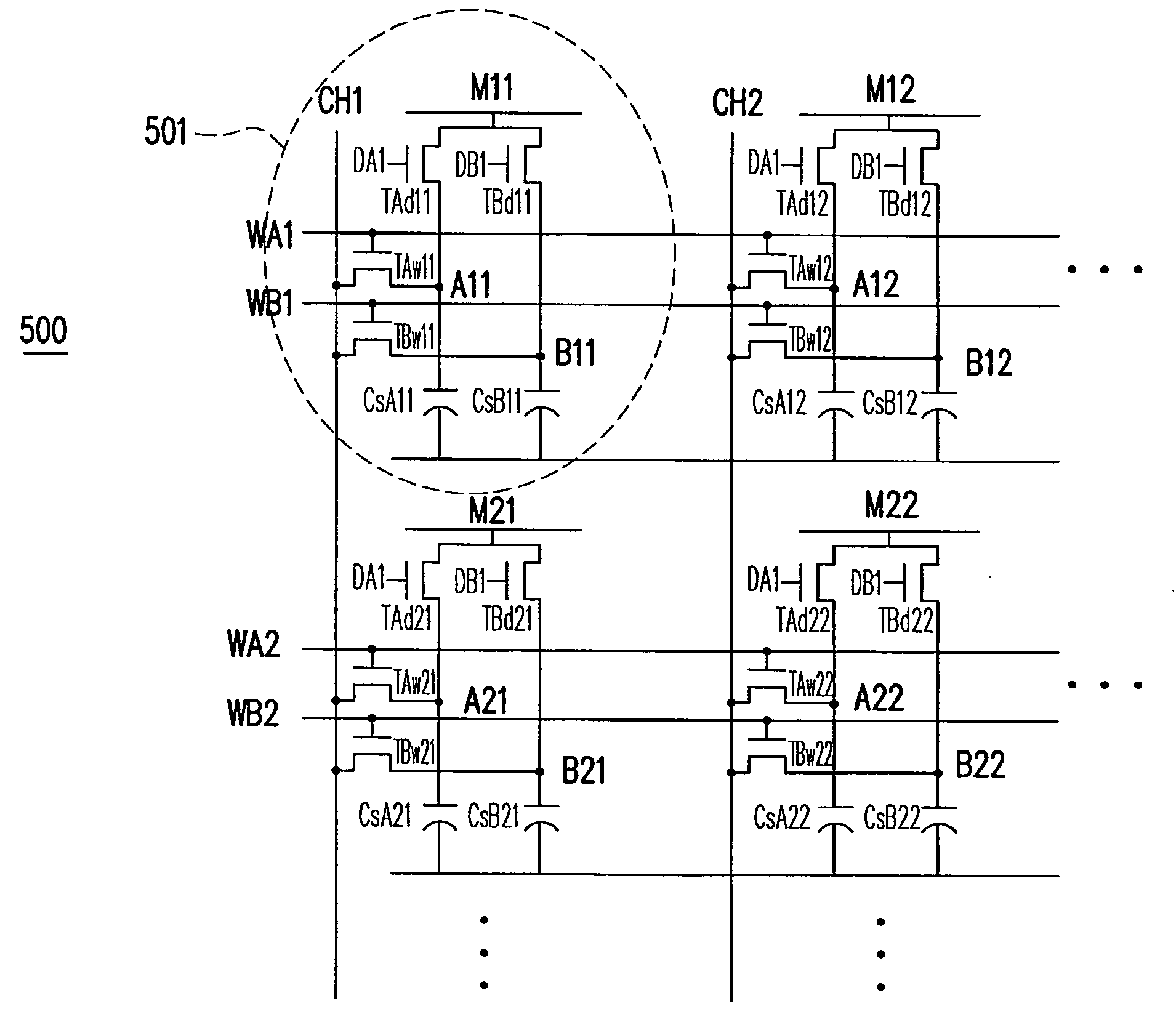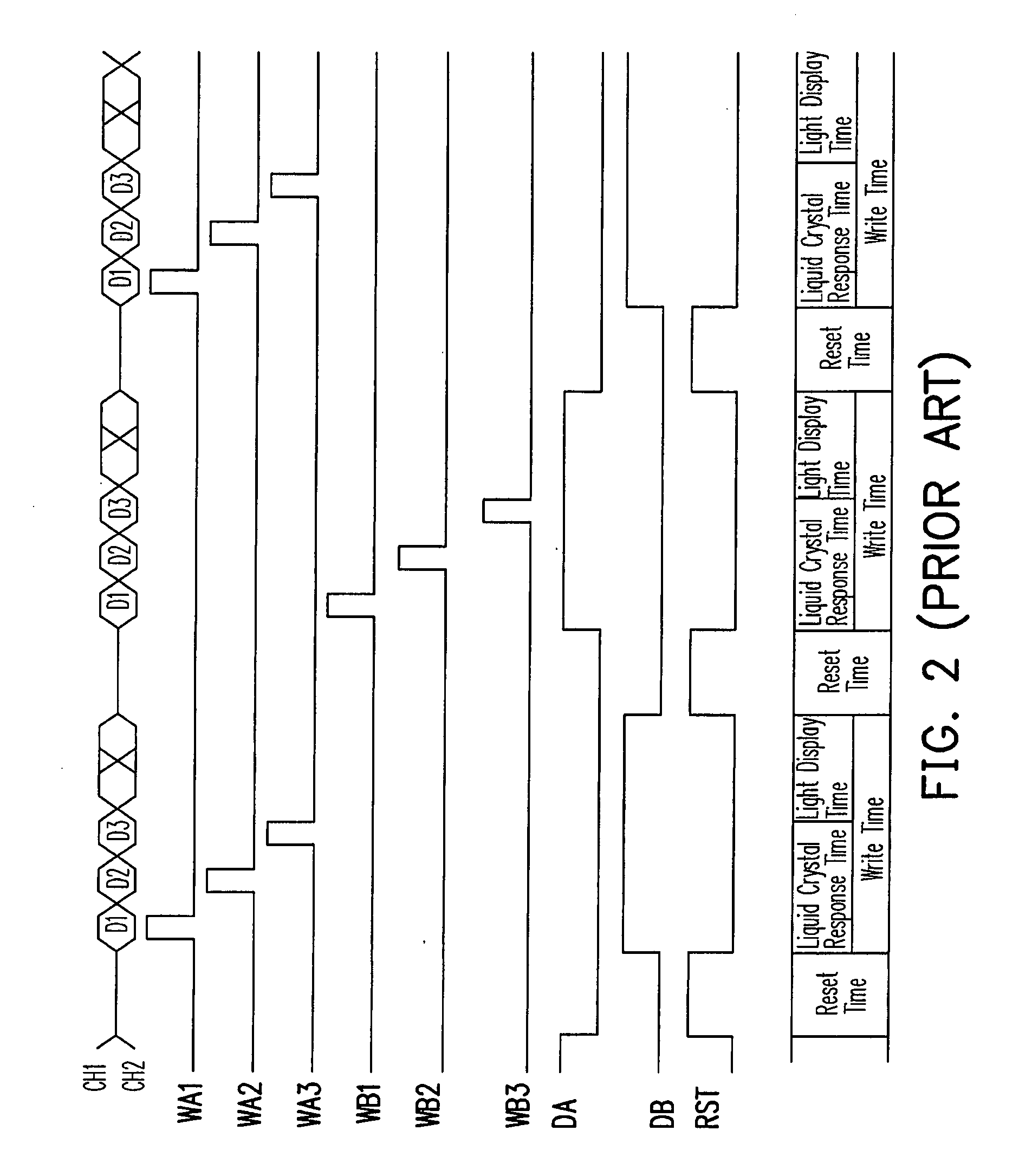Method for driving liquid crystal display
a liquid crystal display and display technology, applied in the direction of instruments, static indicating devices, etc., can solve problems such as deteriorating display quality, and achieve the effect of reducing display brightness distortion
- Summary
- Abstract
- Description
- Claims
- Application Information
AI Technical Summary
Benefits of technology
Problems solved by technology
Method used
Image
Examples
first embodiment
The First Embodiment
[0025]FIG. 3 is a driving circuit diagram of a liquid crystal unit according to a first embodiment of the present invention. In this embodiment, switches are implemented by transistors, and each transistor has a gate, a drain, and a source. Referring to FIG. 3, the liquid crystal unit 300 includes a first switch S1, a first capacitor C1, a second switch S2, a pixel electrode M11, and a reset switch Srst. The gate of the first switch S1 is coupled to a scan line WA, and the source is coupled to a data line CH1, and the drain is coupled to a first end of the first capacitor C1. The second end of the first capacitor C1 is coupled to a ground end GND. The gate of the second switch S2 is coupled to a display signal line DA, the source is coupled to the first end of the first capacitor C1, and the drain is coupled to the pixel electrode M11. The gate of the reset switch Srst is coupled to the reset signal line RST, the source receives a reset voltage signal Vrst, and t...
second embodiment
The Second Embodiment
[0028]FIG. 5 is a driving circuit diagram of a liquid crystal display according to a second embodiment of the present invention. In this embodiment, switches are implemented by transistors, and each transistor has a gate, a drain, and a source. Referring to FIG. 5, the liquid crystal display 500 includes a plurality of liquid crystal units. For example, the liquid crystal unit 501 includes a first and a second write-enable switches TAw11 and TBw11, a first and a second storage capacitors CsA11 and CsB11, a first and a second display-enable switches TAd11 and TBd11, a pixel electrode M11, and a data line CH1. The liquid crystal display 500 displays a first frame and a second frame in a first and a second frame time respectively, and each of the first and the second frame time further includes a liquid crystal response time, a light display time, and a reset time.
[0029]The gate of the first write-enable switch TAw11 is coupled to a first scan line WA1, the source ...
third embodiment
The Third Embodiment
[0034]FIG. 7 is a driving circuit diagram of a liquid crystal display according to a third embodiment of the present invention. In this embodiment, switches are implemented by transistors, and each transistor has a gate, a drain, and a source. Referring to FIG. 7, the liquid crystal display 700 includes a plurality of liquid crystal units. For example, the liquid crystal unit 701 includes a first and a second write-enable switches TAw11 and TBw11, a first and a second storage capacitors CsA11 and CsB11, a first and a second display-enable switches TAd11 and TBd11, a pixel electrode M11, a data line CH1, and a reset switch Tr11. The liquid crystal display 700 in a first and a second frame time displays a first and a second frames, and each of the first and the second frame time further includes a liquid crystal response time, a light display time, and a reset time.
[0035]The gate of the first write-enable switch TAw11 is coupled to a first scan line WA1, the source...
PUM
 Login to View More
Login to View More Abstract
Description
Claims
Application Information
 Login to View More
Login to View More - R&D
- Intellectual Property
- Life Sciences
- Materials
- Tech Scout
- Unparalleled Data Quality
- Higher Quality Content
- 60% Fewer Hallucinations
Browse by: Latest US Patents, China's latest patents, Technical Efficacy Thesaurus, Application Domain, Technology Topic, Popular Technical Reports.
© 2025 PatSnap. All rights reserved.Legal|Privacy policy|Modern Slavery Act Transparency Statement|Sitemap|About US| Contact US: help@patsnap.com



